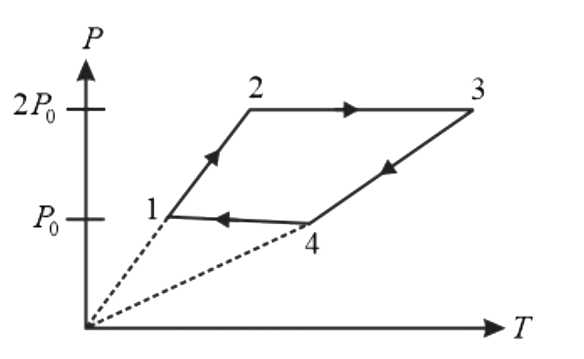For the process, 1 Ar (300 K, 1 bar) 1 Ar (200 K, 10 bar), assuming ideal gas behaviour, the change in molar entropy is
The correct Answer is:A
To find the change in molar entropy (ΔS) for the process where 1 mole of Argon gas is changed from 300 K and 1 bar to 200 K and 10 bar, we can use the formula for the change in entropy when both temperature and pressure change:
ΔS=nCpln(T2T1)−nRln(P2P1)
Step 1: Identify the parameters
- n=1 mole (since we are dealing with 1 Ar)
- T1=300K
- T2=200K
- P1=1bar
- P2=10bar
Step 2: Determine the value of Cp for Argon
For a monoatomic ideal gas like Argon, the molar heat capacity at constant pressure Cp is given by:
Cp=52R
Where R (the gas constant) is approximately 8.314J/(mol⋅K).
Calculating Cp:
Cp=52×8.314=20.835J/(mol⋅K)
Step 3: Substitute values into the entropy change formula
Now we can substitute the values into the entropy change formula:
ΔS=1×20.835ln(200300)−1×8.314ln(101)
Step 4: Calculate the logarithmic terms
Calculating the logarithmic terms:
1. For the temperature term:
ln(200300)=ln(23)≈−0.4055
2. For the pressure term:
ln(101)=ln(10)≈2.3026
Step 5: Substitute the logarithmic values back into the equation
Now substituting these values back into the equation:
ΔS=20.835×(−0.4055)−8.314×2.3026
Calculating each term:
1. First term:
20.835×(−0.4055)≈−8.447
2. Second term:
8.314×2.3026≈19.157
Step 6: Combine the results
Now combine the results:
ΔS=−8.447−19.157≈−27.604J/(mol⋅K)
Final Result
The change in molar entropy is approximately:
ΔS≈−27.6J/(mol⋅K)
- n=1 mole (since we are dealing with 1 Ar)
- T1=300K
- T2=200K
- P1=1bar
- P2=10bar
For a monoatomic ideal gas like Argon, the molar heat capacity at constant pressure Cp is given by:
Now we can substitute the values into the entropy change formula:
Calculating the logarithmic terms:
ln(200300)=ln(23)≈−0.4055
ln(101)=ln(10)≈2.3026
Now substituting these values back into the equation:
20.835×(−0.4055)≈−8.447
8.314×2.3026≈19.157
Now combine the results:
The change in molar entropy is approximately:
Similar Questions
The number of moles of H2 in 0.224 L of hydrogen gas a STP (273 K, 1 atm) assuming ideal gas behaviour is
View SolutionFor the reaction at 300 K , A(g)→B(g)+E(g),ΔH∘=−30KJmol−1 , the decrease in standard entropy is 0.1KJK−1mol−1.The equilibrium constant K for the reaction is ________.
View SolutionWhich of the following exert highest pressure at 300 K and 4 L volume (assume ideal behaviour) ?
View SolutionFor the process H2O(l)(1bar,373K)→H2O(g)(1bar,373K) the correct set of thermodynamic parameters is
View SolutionWhen 3.0 mole of an ideal diatomic gas is heated and compressed simultaneously from 300K, 1.0 atm to 400K and 5.0atm, the change in entropy is (Use CP=72R for the gas)
View SolutionIn an isothermal process at 300 K, 1 mole of an ideal gas expands from a pressure 100 atm against an external pressure of 50 atm. Then total entropy change (Cal K−1) in the process is -
View SolutionN2 gas is heated from 300 kg temperature to 600 k through an isobaric process. Then find the change in the entropy of the gas (n = 1 mole )
View SolutionThe average rms speed of molecules in a sample of oxygen gas at 300 K is 484ms−1., respectively. The corresponding value at 600 K is nearly (assuming ideal gas behaviour)
View SolutionOne mole of an ideal monoatomic gas undergoes a cyclic process, as shown in the figure. If the temperature of the gas at state 1 is 300 K and at state 4 is 500 K, then heat exchanged during process 2→3, is
 View Solution
View SolutionWhen two moles of an ideal gas (Cp.m.=52R) heated form 300K to 600K at constant pressure, the change in entropy of gas (ΔS) is:
View Solution

